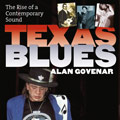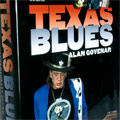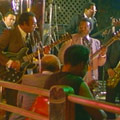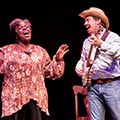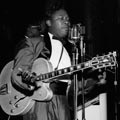Texas Blues: The Rise of a Contemporary Sound
by Alan Govenar
About
Details: 624 pages, Hardcover, Full-Color, ISBN: 158544605X
Publisher: Texas A&M University Press, November 2008
Format: 8.8 x 1.8 x 11.3 in.
Texas Blues allows artists to speak in their own words, revealing the dynamics of blues, from its beginnings in cotton fields and shotgun shacks to its migration across boundaries of age and race to seize the musical imagination of the entire world.
Fully illustrated with 495 dramatic, high-quality color and black-and-white photographs--many never before published--Texas Blues provides comprehensive and authoritative documentation of a musical tradition that has changed contemporary music. Award-winning documentary filmmaker and author Alan Govenar here builds on his previous groundbreaking work documenting these musicians and their style with the stories of 110 of the most influential artists and their times.
From Blind Lemon Jefferson and Aaron "T-Bone" Walker of Dallas, to Delbert McClinton in Fort Worth, Sam "Lightnin'" Hopkins in East Texas, Baldemar (Freddie Fender) Huerta in South Texas, and Stevie Ray Vaughan in Austin, Texas Blues shows the who, what, where, and how of blues in the Lone Star State.
Reviews
1/15/2009| Library Journal
by William G. Kenz, Minnesota State University, Moorhead
As this massive, vibrant, and colorful study shows, the importance of Texas Blues is demonstrated by the number of musicians who have practiced or are practicing this art. The coverage is expansive, with introductory essays, interviews conducted by Govenar and others, and a wealth of photographs. Govenar (Meeting the Blues) manages to profile an amazing number of guitarists, pianists, singers, and others, both well known and obscure, who show how much pioneering blues musicians like T-Bone Walker and Lightnin' Hopkins influenced their own development. The discussion of the role played by tiny establishments, radio stations, country music, and several key record labels is particularly enlightening. These vignettes, along with a carefully chosen discography and bibliography, contribute to making this a special book on the blues field, particularly its Texas developments. Recommended for all libraries, especially those with large music holdings.
True Blues| The Austin Chronicle
Alan Govenar's encyclopedic preservation and correction of blues mythos
by MARGARET MOSER
There may be no regional genre of music more prone to tooting its own horn than Texas blues, and with good reason. Alan Govenar's new book, Texas Blues: The Rise of a Contemporary Sound (Texas A&M University Press, $40), is the finest, most comprehensive roundup yet, at more than a whopping 600 pages and with nearly 500 photos in color and black and white.
The photos tell their own stories in vivid tones, historic ephemera showing cotton fields, advertisements, record labels, sheet music, juke-joint signs, and posters, some of the latter apt reminders that next to Robert Crumb, Austin's Jim Franklin created the most compelling images of blues artists. The faces tell another story of Texas blues: a stiff-backed T-Bone Walker in front a 1920s medicine-show tent; a brooding, pompadoured Freddy Fender hunched over – what else? – his Fender; Robert Ealy grinning and biting on a stogie; Shemekia Copeland's gold braids contrasted on her copper skin; a dapper Clarence Garlow; and Stevie Ray Vaughan, forever young with Paul Ray & the Cobras.
Yet what drives this massive chronicle more than the images is the rich language of the witnesses. Produced as an oral history, Texas Blues approaches its subject by blues region of the Lone Star State, with additional chapters on electric blues and the saxophone, the California migration, and zydeco. It's an effective medium that allows Govenar to record many aspects of blues, from musical and sociological to political, in the music's own voice.
Truth is dicey, however.
Memory becomes faulty, or a timeworn tale gathers new details with repeated retellings. Sometimes the process of recalling history is prone to chronological misplacement, even by the participant. In the Austin chapter, W.C. Clark cites the rise of his band Southern Feeling as coming after Triple Threat Revue when the opposite is true. It's Clark's story to tell, of course, even with a grain of the don't-let-the-facts-get-in-the-way-of-the-story salt.
Mythology occurs on all levels of history, but art articulates it through paintings, dance, words, and music. Blues particularly enjoys a broad spectrum of emotions, and the desire to heighten one's importance seems inherent in the sound. Some of the mythos is self-generated; witness early 1960s interviews by John Lomax wherein Muddy Waters merely cites Robert Johnson's influence. A decade later, Waters describes shows he played with Johnson. At other times, myth is perpetuated for effect, such as blues queen Bessie Smith dying after being turned away from a white hospital. In fact, Smith died in an ambulance on the way to a black hospital in Clarksdale, Miss.
Big-fish myths of the genre serve an important purpose as it turns out: They keep the mystique intact. Such stories also exist on a local level. Just ask Blues Boy Hubbard about Bobby Blue Bland at the Victory Grill. Austin's veteran guitarist is quick to growl that Bland only appeared a couple of times at the venerable Eastside nightspot. That Bland is most often cited as its biggest success chaps Hubbard, who toiled there six nights a week for years. And if you're in San Antonio and lucky enough to chat up Curly Mays, he'll grouse that Spot Barnett played mostly at the Ebony Club, not the Eastwood Country Club where Mays was the man but Barnett now gets the glory. So what is the truth when, as Delta Blues author Ted Gioia writes, "facts are scarce and stories often incomplete or confusing"?
Texas Blues author Govenar recognizes that disparity but finds meaning in verbatim conversation, noting that "the beauty of oral history is the way people reveal and talk about the multitude of influences upon their music. Through that, one realizes the complexity and the vast patchwork that creates blues and how it is informed by many other forms of music."
Govenar freely acknowledges the all-too-human mistakes that occur, such as Clark's. He has concise thoughts on blues mythology and a passion for the subject. Historian, documentarian, and photographer, Govenar also makes a convincing case for Blind Lemon Jefferson as the father of blues over the more fabled Robert Johnson. His current project is writing about Lightnin' Hopkins, a Texas bluesman with no shortage of mythology in a genre rife with it.
"Over the last three decades, the media tended to mythologize Mississippi blues as being primary in the development of this vast music," explains Govenar. "One of the real linchpins in this argument is Robert Johnson, though if you look a generation earlier, it's Charley Patton. Patton was a contemporary of [Texan] Blind Lemon Jefferson. And Jefferson was the first country-blues performer to be recorded.
"Jefferson was the most prolific, biggest selling blues performer of his time. He made more than 80 recordings in a little more than three and a half years. From a guitar styling standpoint to his general approach to music, he was doing many of the things Robert Johnson is credited with, only 10 years earlier. Robert Johnson is as well known as he is because of the great appeal he had to white blues-rockers and rock & rollers, particularly the Rolling Stones and British performers.
"Blind Lemon is much lesser known, although 'Matchbox Blues' was covered by Carl Perkins and the Beatles. To a large extent, Blind Lemon's music remains unknown because the fidelity of the original recordings are so poor that you only get a glimpse of who he was. People who heard him play marveled at his approach to the guitar, his versatility, the drive, the energy he brought to his playing."
It's a compelling presentation and one that begins early in Texas Blues with Paul Oliver's foreword, in which he suggests the primacy of the Lone Star State's contribution to the genre over that of Mississippi. Govenar's research and interviews took him deep into the 19th century to examine the roots of American blues.
"So the question becomes, where were the blues born? It certainly wasn't born in one place. It was a result of the times, the music of newly freed African-Americans. People agree generally that the blues emerged in the 1890s. It seems to me that Texas and Texas rhythm & blues likewise is not clearly understood. In many ways, the Texas blues sound fed directly into what's called the contemporary blues, but at the same time, it has its own integrity.
"Most of the people in my book of a certain generation talk about T-Bone Walker. He was it. That's who they mythologized. T-Bone Walker was a seminal figure with a direct link to Blind Lemon Jefferson. He applies some of the guitar technique of Blind Lemon to the playing of the electric instrument and transforms it from a rhythm instrument to a lead instrument. In effect, Walker creates the modern sound of the electric guitar.
"People connect to the feeling of the blues. It's the expressive quality of the music, the feeling of truth that the music echoes and resounds – that truth of emotion, being able to lay out there how you feel in a poetic way."
